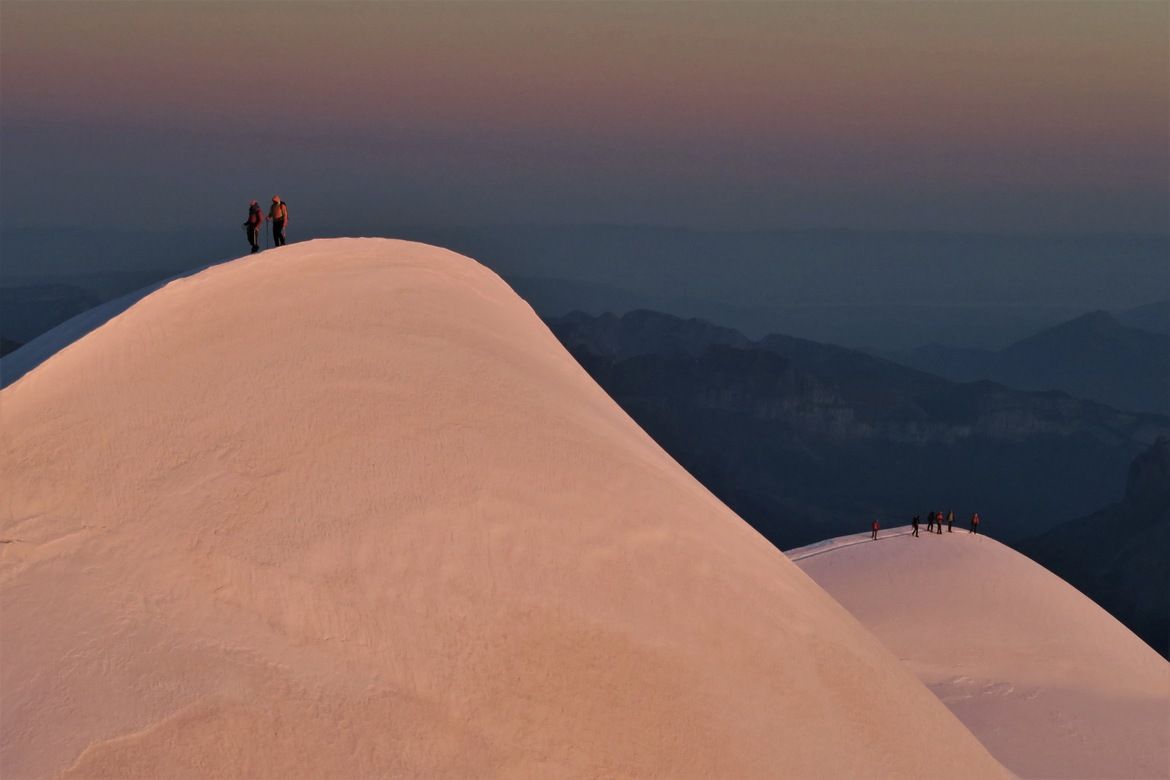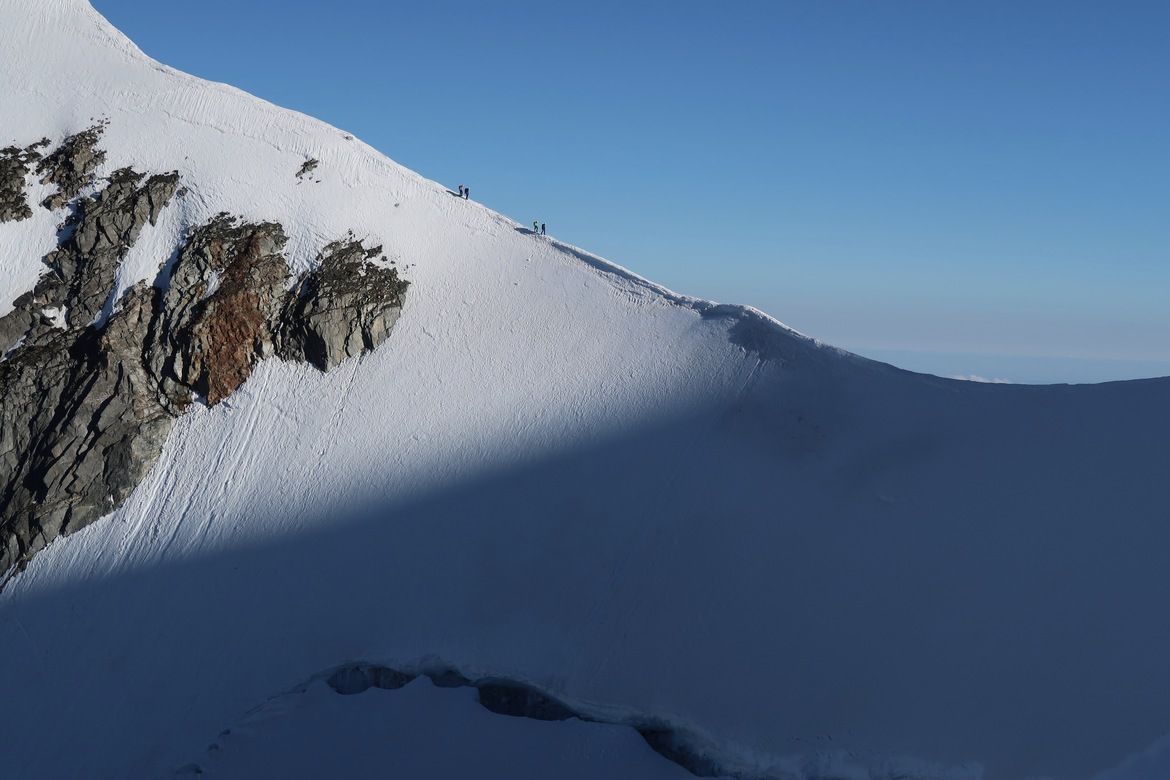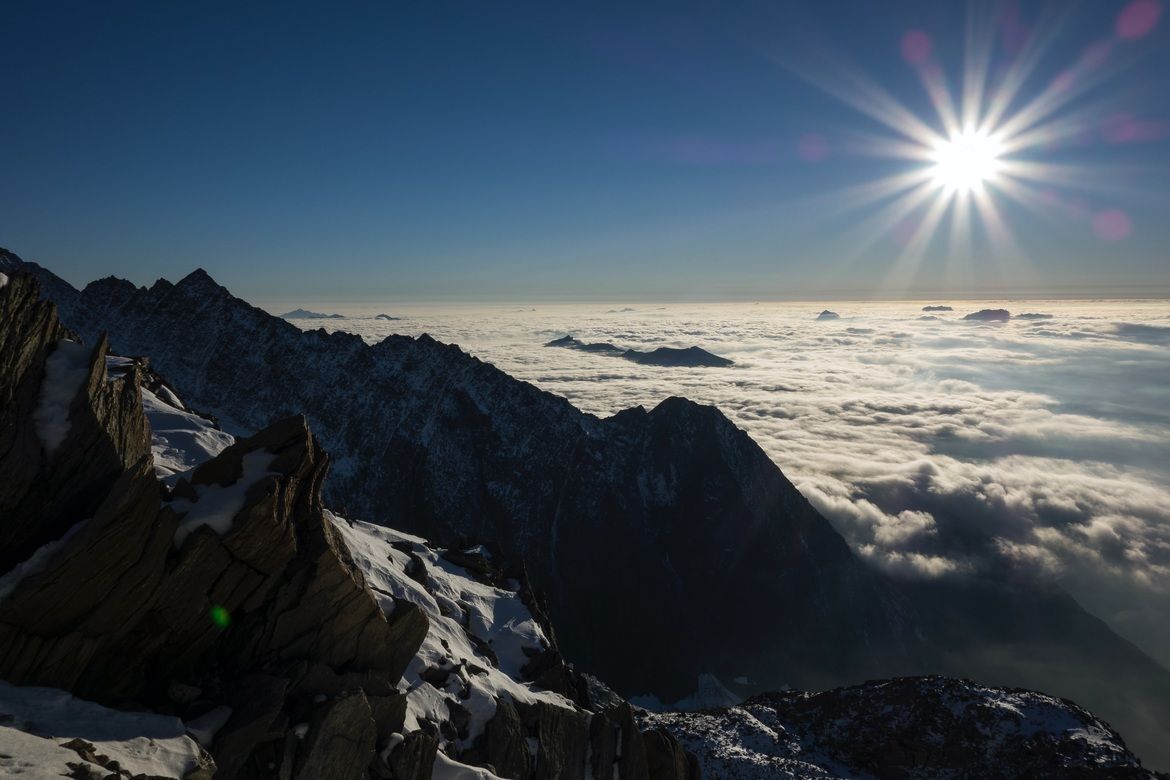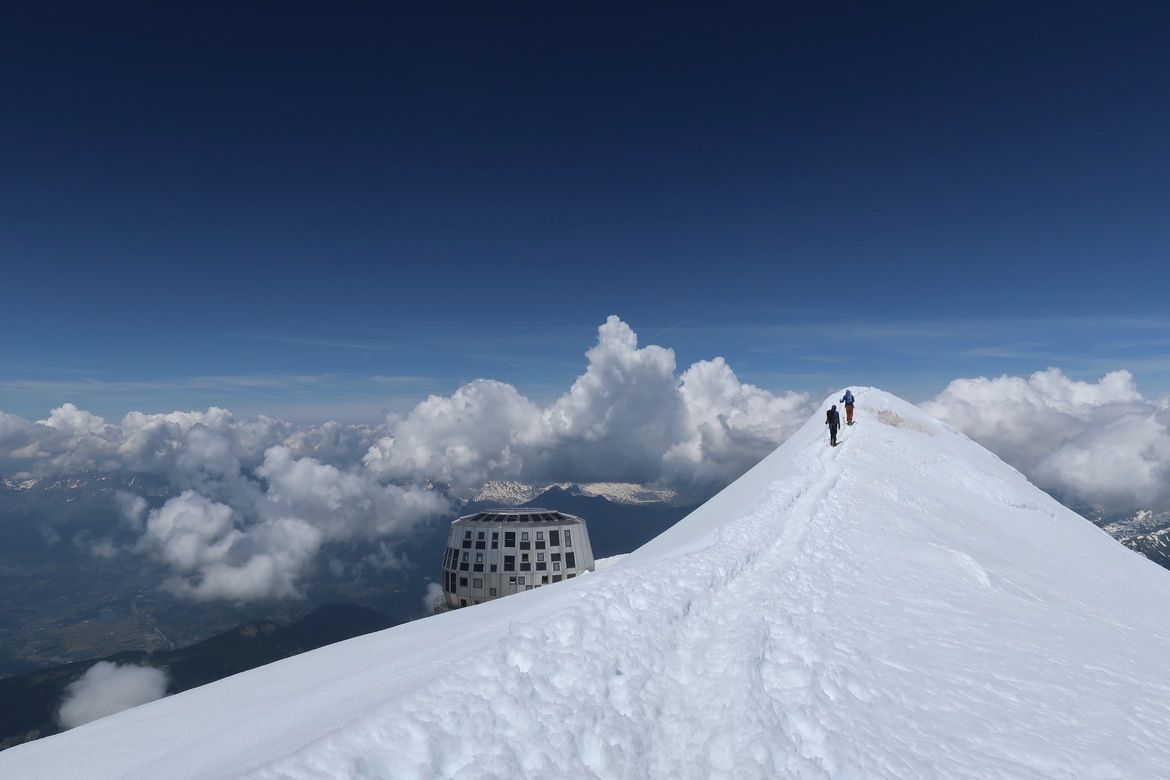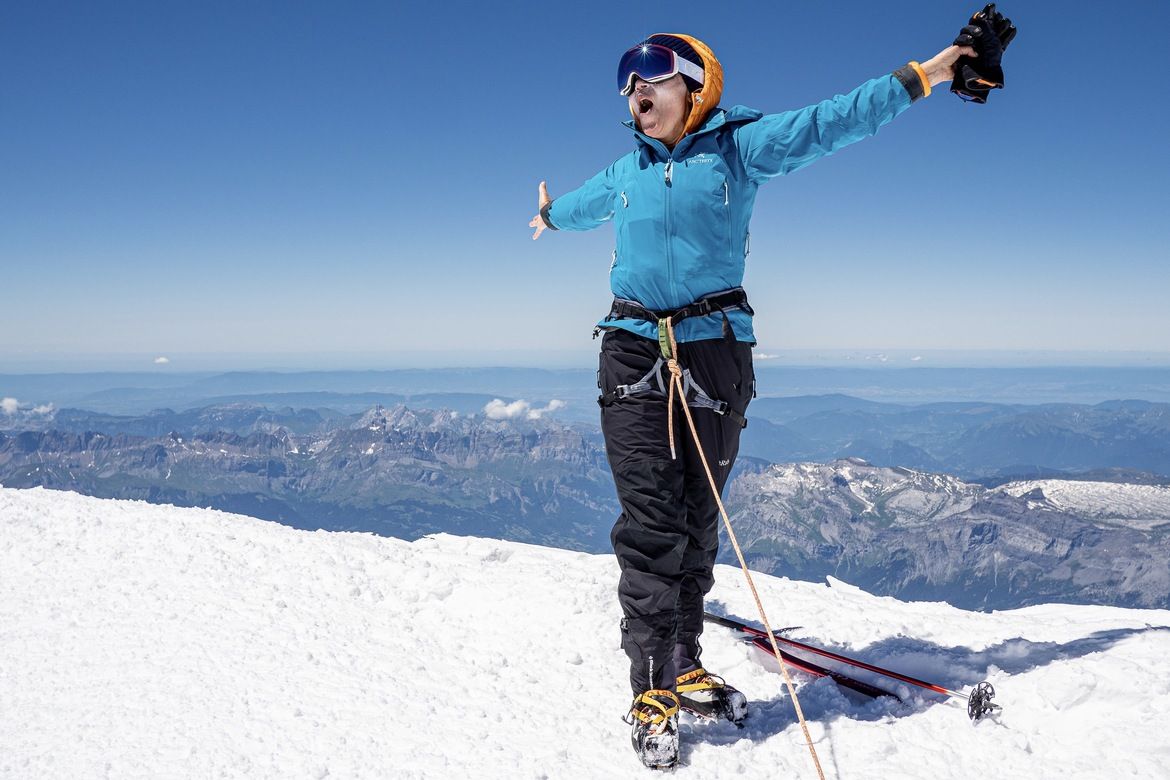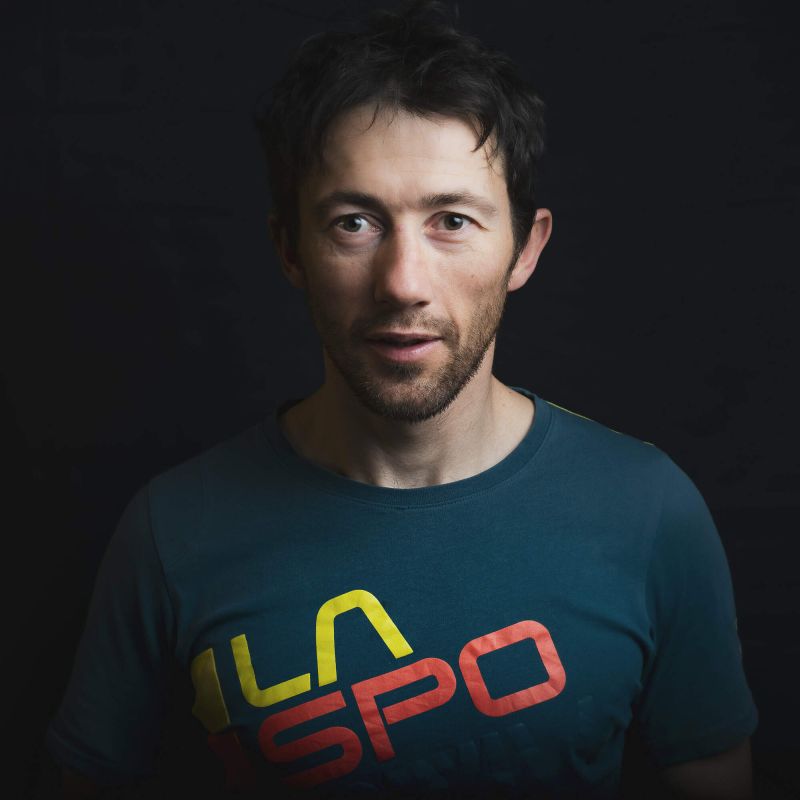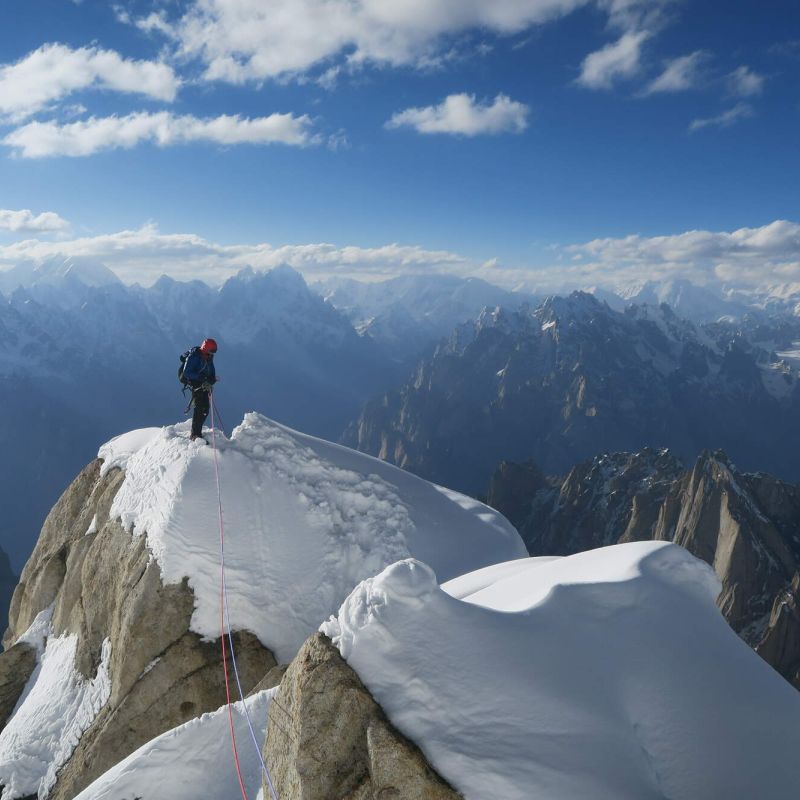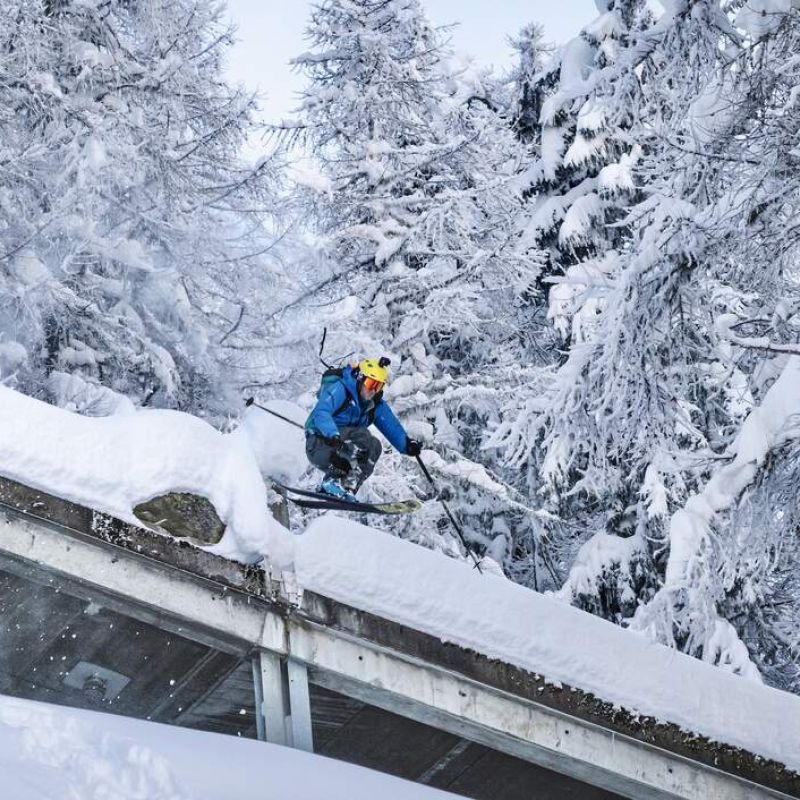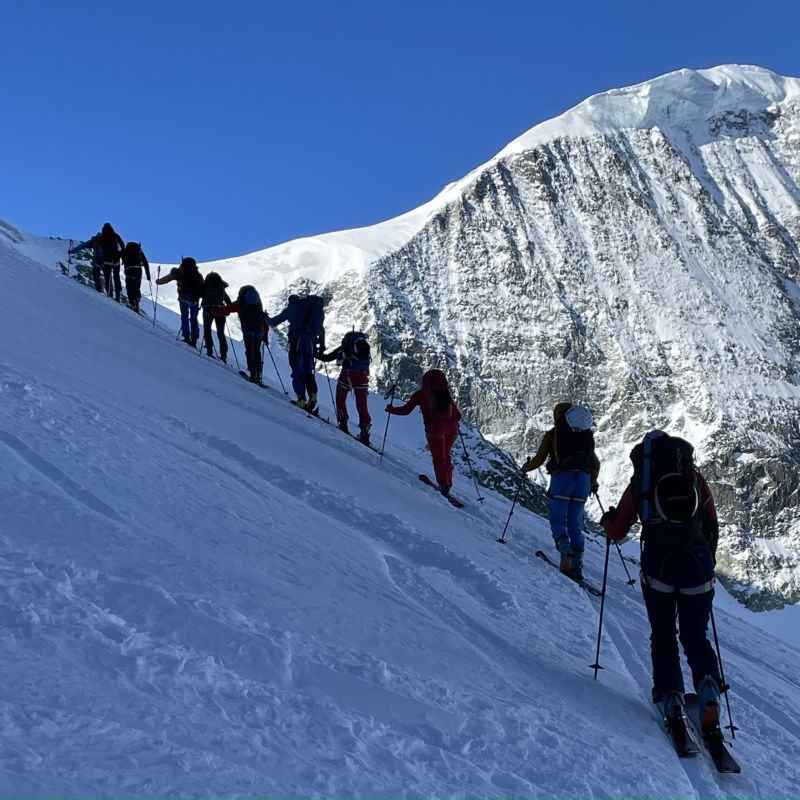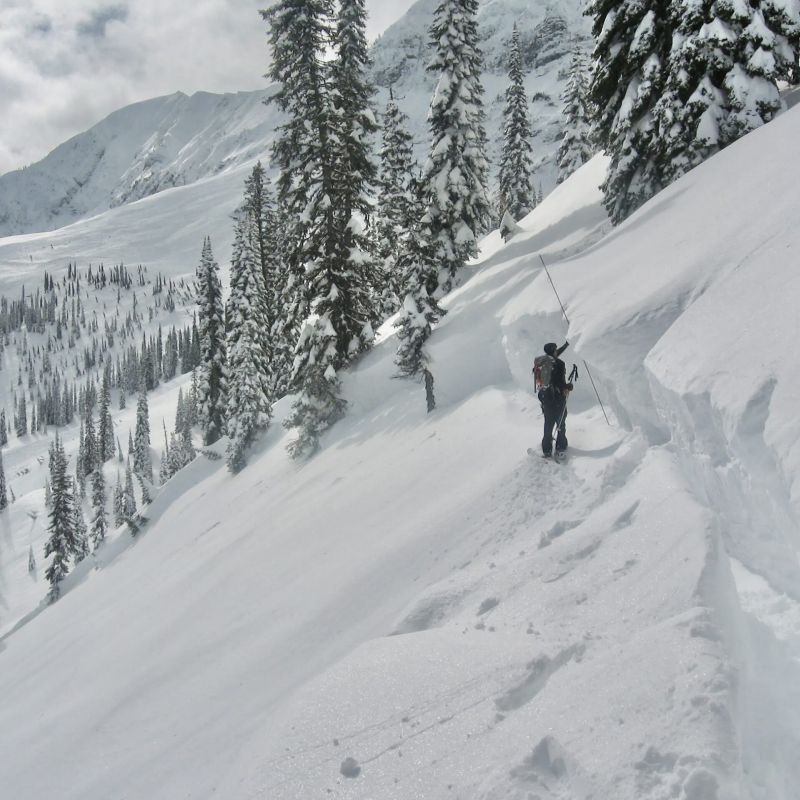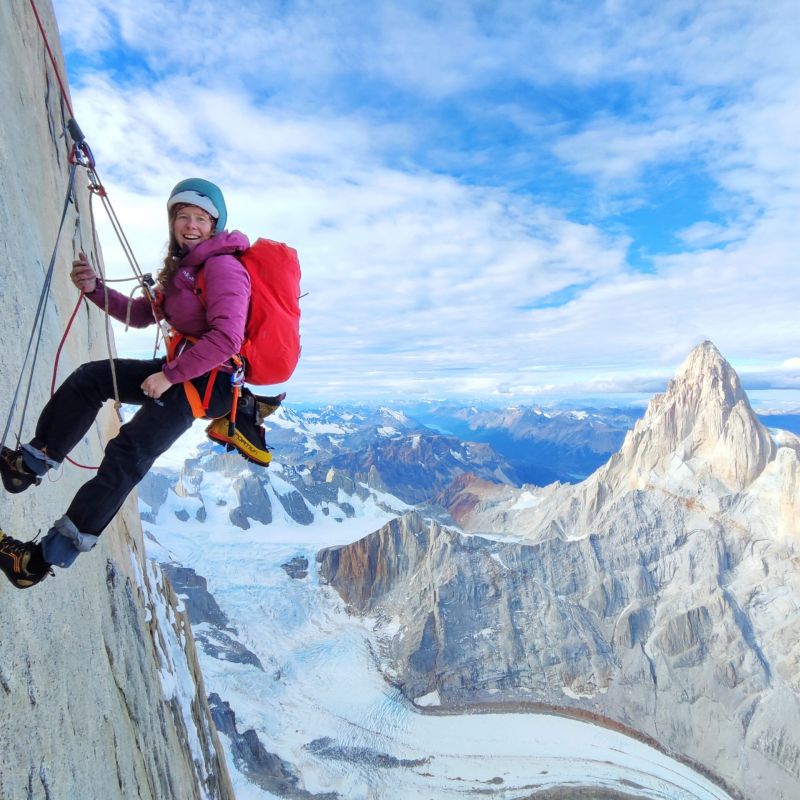The Mont-Blanc handbook
Mont-Blanc: The Highest Peak in the Western Alps
Mont-Blanc (4,810m) is the highest point in the Western Alps. First ascended in 1786, it remains a significant challenge for mountaineers in the 21st century. The summit draws climbers of all levels worldwide. Its various faces and routes reflect different climbing eras, each linked to the legendary mountaineers of their time. Chamonix, often called the birthplace of alpinism, nestles below, surrounded by steep rocky towers, chaotic crevasses, high valley pastures, and a vibrant community of locals and visitors.
How Did the Mont-Blanc Climbing Frenzy Start?
The first ascent in 1786 was a milestone for mountaineering and expanded the idea of what was possible. Horace-Benedict de Saussure, a leading Genevan scientist, inspired by scientific curiosity, put up a bounty for the first successful summit. After a failed attempt and a cold bivouac on the glacier, Jacques Balmat demonstrated courage and persistence, overcoming fears of the glacier’s “demons.” Together with Michel-Gabriel Paccard, a young local doctor and multiple-time summit hopeful, they set off laden with scientific instruments (including a barometer to take readings at the top) and wooden poles used as ice axes.
Their route started at the Bossons glacier, beginning from La Junction—a high rocky outcrop where they camped overnight before summiting. On August 8, 1786, thanks to perfect weather, a full moon, and good fortune, they reached the summit and safely returned. The Grands Mulets route, popular for late spring or early summer skiing, closely follows this historic first ascent line.
Following this groundbreaking climb, Mont-Blanc became the focus of many scientific explorations and mountaineering expeditions. The first woman to reach the summit, Marie Paradis, climbed in 1808 but suffered from altitude sickness symptoms such as shortness of breath, fatigue, and speech loss.
In 1887, Joseph Vallot spent three days and nights on the summit to prove high-altitude survival, building an observatory in 1890 below the summit. Astronomer Pierre Janssen also built a summit observatory that same year, but it was lost to the glacier’s movement. The Vallot observatory and its emergency bivouac remain active today, aiding climbers on the Gouter route and high-altitude physiological research.
As alpinism grew and technology evolved, new routes opened around Mont-Blanc. The Italian normal route (via the Aiguilles Grises) was first descended before being climbed. Though interrupted by two world wars, the tradition continued with more technically demanding climbs pushed by Himalayan expeditions. Recently, speed ascents have regained popularity, with athletes like Kilian Jornet setting the record—climbing and descending in under five hours (4h57min34sec) from Chamonix’s church.
The Guides: A Tradition of Mountain Expertise
A Mont Blanc climbing guide’s perspective is always unique, but the undeniable prosperity that Mont Blanc has brought to both the Chamonix and Aosta valleys is a testament to its lasting appeal. The history of mountain guiding here began with porters and local mule owners navigating high mountain passes. This soon evolved as Victorian-era travelers sought fresh glacier air and the healing thermal baths nearby—used to treat ailments such as scurvy, epilepsy, skin disorders, and ulcers. With rising visitor numbers, fatalities also increased, culminating in a tragic 1820 expedition where three guides lost their lives. In response, the Compagnie des Guides de Chamonix was founded in 1821 to support the families of guides and better distribute an increasing workload. This marked the beginning of a golden age in the Mont Blanc range, where many mountain passes and 4000-meter summits were first ascended. Alpinism as a recreational pursuit took firm root in the Alps and continues to thrive today, except for interruptions caused by wartime.
A dedicated Mont Blanc climbing guide may summit the peak over 100 times during their career, sometimes even 10 to 15 times in a single summer season. St. Gervais guides who lived at the Gouter hut historically managed daily summits during extended spells of good weather, greeting new clients each morning and seeing them off by afternoon. Though official records are limited, folklore fueled by genepi suggests some St. Gervais guides have summited Mont Blanc more than 500 times!
The rich guiding tradition remains strong today. Most successful Mont Blanc climbing parties rely on the expertise of local guides. The benefits of hiring a Mont Blanc climbing guide include intimate knowledge of current mountain conditions, assistance with complex hut bookings, help with technical gear, skill development, and maintaining the right climbing pace. While most guides are French, many international guides have made Chamonix their home. Passionate about the mountains, guides often balance a full schedule of clients with time for their own climbing and skiing pursuits. With around 20,000 Mont Blanc ascents annually, demand in Chamonix’s peak season often exceeds the number of available guides.
The Routes to Mont-Blanc Summit
Most ascents will come from one of three routes. All are long, technical, and demand fitness and training. From the French side – either the three Mt. Blancs route from the Aiguille du Midi or the Gouter route from St. Gervais or Les Houches.
Three Mont-Blancs Route (Aiguille du Midi)
The prior is entirely on glaciated terrain- climbing prominent parts of the Mt. Blanc du Tacul (1 Mont) and the Mt. Maudit (2 Monts), typically without actually summiting either. Exposed to falling ice from overhanging glaciers and almost entirely above 4000m, this route remains popular because of its proximity to the Aiguille du Midi. If the Mt. Blanc summit seems close at 4810m (3 Monts) from the summit of the Aiguille at 3860m it is an illusion – complex and dangerous terrain divide the two points. Most ascents leave the Cosmique Refuge, near the base of the Aiguille du Midi, at 2 a.m. to achieve the summit at a reasonable hour.
The Gouter Route (Most Popular)
Far more commonly undertaken, and thus more commercial, is the Gouter route. Our Mont Blanc courses take this itinerary. While not as technically demanding as other routes to the top, this route should not be taken lightly. Train access to the Nid D’aigle (2362m) and an approach hike allow access to the Tete Rousse Hut (3167m). This is typically the first night on a Chamex led trip. Two hours of technical scrambling from the Tete Rousse bring one to the recently constructed Gouter Refuge (3835m) for a brief break. Route finding and scrambling abilities are important up and down the Aiguille du Gouter’s west facing rock face. Global warming has drastically altered the route’s general conditions- making it impracticable in a warmer summer’s hottest stretches. Rock fall in the exposed Grand Couloir can be the cause of multiple accidents each season. Getting back and forth between the two huts is the technical crux.
From the Gouter hut the climbing changes from steep scrambling to lower angle glacial walking, as the Dome de Gouter is confronted. After approximately two hours Vallot’s bivouac is reached. The terrain steepens just before the hut, and the remainder of the route requires careful crampon use and attentive footwork. The Bosse arête resembles the humps on a camel’s back from Chamonix – but the difficulty of each step is magnified by the altitude and growing fatigue. Another hour – and the final summit crest is reached. The terrain is continually less steep – this unfortunately creates the illusion of an ever escaping summit- until the final summit plateau is attained. The descent to the Gouter Hut retraces the steps used to ascend- much easier but still requiring unwavering focus – it’s exposed! As the descent continues oxygen is more easily absorbed, and a celebratory beer awaits in the hut.
Italian Route (Miage Glacier and Gonella Hut)
The Italian route from the Miage glacier and the Gonella hut (3071m) is the third and least popular option, though it can be an attractive alternative to the more commercial French side. Longer and more dependent on good glacier conditions, it requires fitter and more experienced alpinists. A long walk up the Val Veny leads to the refuge, and the 1400 meters of elevation gained on the approach the first day are only a third of the effort required to summit via the 1700 meters climbed past the Aiguilles Grises to the top. The Glacier du Dome is large, complex, and wild. Late season attempts may be thwarted by an impenetrable labyrinth of crevasses, revealed when winter’s snow has disappeared. The Italian route joins the Gouter route at the Dome de Gouter, and the final hours to the summit are shared along the Mt. Blanc’s northwestern crest.
Other Variations
Other popular variations include the Royal traverse – tackling the Domes de Miage and the Aiguille de Bionnassay before arriving at the top of the Dome de Gouter – and the Grands Mulets route. The former offers a spectacular snow ridge traverse at 4000m, and the latter is the most popular ski touring variation, and is most similar to the route ascended by Balmat and Paccard on the first ascent. Both require alpine experience in the each domain. Skiing the Mt. Blanc is a long and technical ski tour for which, while generally only 2 days, requires good acclimatisation to be best enjoyed. The Royal traverse is a mission for trained mountaineers who have good endurance.
Each summit route has it’s own satisfaction, and each summit- even done multiple times by the same route – is unique and rewarding. While no longer the pioneering adventure upon which Balmat and Paccard endeavoured almost 250 years ago, the view from the top is undoubtedly similar to what they must have seen, and the elation of arriving on the top of Western Europe is an emotion shared by mountaineers from around the world.
Preparation for Mont Blanc: Training & Techniques
Modern Mont-Blanc trips are more focused on preparation – clients will spend three or four days preparing and two or three days on the Mt. Blanc. This allows the best chances of success, as every client who attempts the climb has the rudimentary skills necessary to summit. In a three day summit push there is also some flexibility with the summit days in case of bad weather. Nature makes the rules in high altitude mountaineering, and even a brief storm or high wind can render the top unattainable.
Why Adequate Preparation Matters
Generally, clients who don’t make it to the top have arrived extremely unprepared. In extreme cases the question has been asked if crampons are needed to get to the top! While the guides and office team may do their best to help one realise their goals, active participation is necessary. Chamex tries to steer pure novice mountaineers away from the Mt. Blanc, and highly recommends, at the very least, a week long introduction to alpinism. This course is the ideal introduction to the many different skills that will render the beginning mountaineer more efficient and better prepared for alpine climbs. A minimum of familiarity with alpine terrain, material, and techniques make for a safe and enjoyable ascent. Chamex offers a Mont Blanc 3 days extension to our Alpine Climbing Level 1 course.
Gaston Rébuffat, famous French alpinist and writer, listed the 100 finest routes in the Mont Blanc range by order of difficulty- from the easiest climbs and training days to the hardest routes on in the range. The Mt. Blanc, by the Gouter route, ranks 24th. In Rébuffat’s opinion a climber would have already spent a minimum of three to four weeks mountaineering and gaining experience prior to attempting the route, if one were to proceed in a progressive manor. While certainly possible for some to go from zero to the top in the space of a week, this remains an exception and is not recommended.
Not every climber has time, access, or the budget to spend on training in the alps. For those that can’t be here – some tips (also valid for those taking an intro to alpinism course!).
Tips for Aspiring Mont-Blanc Climbers
Don’t underestimate Mont-Blanc’s difficulty
Do not underestimate how difficult the Mt. Blanc is. Just because your neighbour did it and told you it was easy does not guarantee your success. Also, memory can be extremely selective, especially in mountaineering.
Prioritize fitness
Multiple, successive days doing long walks, running, cycling, stair master, avoiding the elevator, etc. are all valid methods to increase one’s overall fitness. Most of the training should emphasise long term endurance, as a typical alpine day can be anywhere from 6-10 hours on the move. You can also find what works for you regarding nutrition and hydration- There is information available for this type of training. You must arrive in shape. You can acclimatise and learn over the space of a three day prep, but your fitness will not improve. Clients who are unfit will be doing other activities- not the Mont Blanc. This rule is for the well being of everyone, and while nobody likes to be told they can’t go it really is best sometimes, -the stubborn, unfit climber has no idea what they are asking their guide to agree to.
Practice climbing skills
Familiarity with basic rock climbing techniques (and some fitness!) will allow you to climb every 4000m peak in the alps. You don’t need to be a great climber- just do what you can, have fun with it, and general alpine terrain will be easy. Poor propriception and an unwillingnness to trust your feet can decelerate your movement to a stop, or require more effort as a result of poor efficiency. A solid climber is also safer.
Gear matters
Shoes are the most important element. While many shops here will rent mountaineering boots, a good pair of your own boots, broken in to your foot shape is best. The boots must be crampon compatible and warm enough for high altitude cold. Boot selection is personal, and fit trumps all other attributes. Also, personal warmth is also extremely individual- if you suffer from cold toes, don’t try with light boots. Compeed or the equivalent (and basic, personal first aid kit) is essential- take care of your feet as it is unfortunate to cancel plans because of sore, infected blisters. Earplugs for noisy dormitories can be very helpful. For the rest of the gear- light is right, and warmth is a priority. Good, functional, technical clothing is important. A lightweight 30-40 liter rucksack. 12 point steel crampons, a classic mountaineering axe, walking poles, harness, helmet may be rented, as well, but it is also possible to shave grams (which often lightens the wallet as well) by making keen selections. Chamex can offer advice, and there is an equipment page on the website.
Research thoroughly
Use your passion to inspire you to do your homework. The physical training and the gear are important; it is also important to know exactly what you are getting into. Thorough preparation is key- every step of your trip should be researched. Knowing the course itinerary, seeing other’s blogs or you tube adventures can really give you an idea about what to expect, and will be expected.
Why to climb Mont Blanc?
While the comfort of the huts, the generally easy access, diligent preparation, and 250 years of advances in hardware, textiles, and navigation increase the chances of success, there are many who are forced to turn back for any number of reasons. If the summit remains elusive to the 21st century mountaineer, this too is an emotion shared by countless failed attempts across almost three centuries. Weather, foot problems and lack of fitness are the most common reasons why the climbing week may end without a summit shot. But the experience gained is an irrevocable precious future commodity (even if you never climb again!).
Much fun lies in the preparation and the challenge as well – the richness of the journey should never be overshadowed by the ultimate goal. Nature does not create or measure summits – and holding oneself to the standards put forth by men is seldom as rewarding as may have been imagined at the outset. The Mt. Blanc was present before and will be standing long after man’s brief history is erased. Each climber has their own unique and valid motivation for seeking a challenge – perhaps best discussed with good wine in a quiet hut after a warm dinner…
The stars in the dark early morning, the Milky Way in full splendour, unspoiled by city lights. The sunrise on the summit, and it’s long shadow stretching across the valley below. The final summit crest- one of the most aesthetic in the alps. Views of potential future objectives – prestigious peaks such as the Matterhorn, Mt. Rosa, the Aiguille Verte and the Grands Jorasses – all appear short from the snowy top. Conditions permitting a picnic and a rest in the sun – enjoying the moment, congratulatory hugs and photos…. The camaraderie developed over the week – a celebration of the fraternity earned suffering, summiting, laughing, eating, learning, together.
